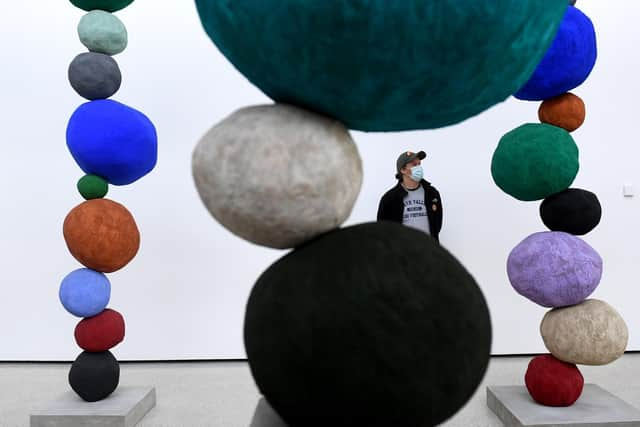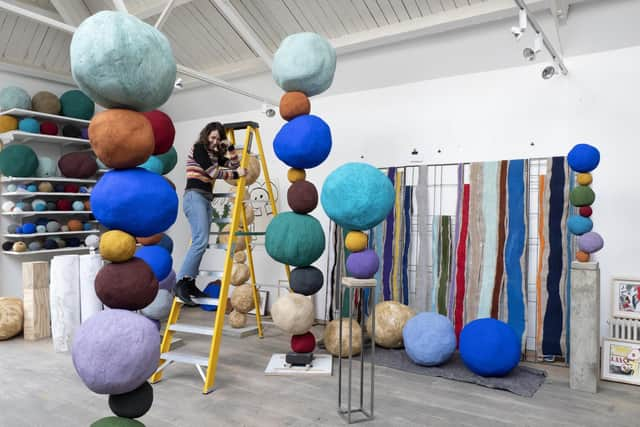Annie Morris's unique stacking sculptures bring a splash of colour to Yorkshire Sculpture Park
When a Happy Thing Falls, which showcases the work of sculptor Annie Morris, is a riot of vibrant hues and immediately brings a smile to your face as you enter the YSP’s Weston Gallery.
An immersive installation made specifically for this show, it features a selection of the artist’s brightly pigmented stacking sculptures alongside one of her tapestries or “thread paintings”. There is also work, including a new bronze piece, in the open air.
Advertisement
Hide AdAdvertisement
Hide AdIt is Morris’ first UK solo museum exhibition and coincides with her show at the Timothy Taylor Gallery in London and her inclusion in Frieze Sculpture 2021. “I first met Annie in 2018; I did some studio visits to view her work and I thought it would fit especially well within our programme ethos,” says Helen Pheby, YSP’s head of curatorial programme.


“Her work talks to people on lots of different levels and appeals to all ages – children love it. Annie’s studio is this wonderful space of energy and colour and creativity and she wanted to recreate that feeling for our visitors. She wanted people to be immersed in a ‘forest of sculptures’ and enter into that dynamic.”
That sense of being amongst tree-like objects is quite palpable. The stacked sculptures – towers of precariously balanced, vividly pigmented lumpen spheres – also feel very human and sit somewhere between the abstract and figurative, between the two-dimensional and the three-dimensional.
They are unique. You can see why children might be drawn to them as they do bring to mind the kind of colours you often find in high-sugar confectionery.
Advertisement
Hide AdAdvertisement
Hide AdThe lack of sharp edges makes the sculptures appear soft and welcoming, even though some are actually made of metal. Formed first by hand in plaster, then cast in bronze, the round forms are painted with raw pigments.


“Annie is fascinated by colour,” says Pheby. “She went to study at the École Nationale Supérieure des Beaux-Arts in Paris between 1997 and 2001 under Giuseppe Penone and the art supplies shop Sennelier was nearby – the shop is famous for inventing oil pastels for Pablo Picasso, and Annie wanted to try and capture the brightness of that pigment.
"She was trying to hold on to the intensity and the vibrancy of the colour so she began experimenting and she has developed over the past 25 years her own technique of plaster sculptures that hold the pigment.”
Morris has described it as “trying to freeze the moment when paint hasn’t yet dried” and she definitely achieves that – there is such an immediacy and freshness about the colour, coupled with the texture of the spheres, that you do feel as though, if you touched it, the colour would come off onto your hand.
Advertisement
Hide AdAdvertisement
Hide Ad“It was also interesting when we installed the exhibition just how art historical it feels,” says Pheby. “I realised it is because Annie is fundamentally concerned with form, line and colour and her palette recalls other eras – the intense blue for example is quite reminiscent of colours you might see in a Renaissance painting by Da Vinci but also in Picasso’s work.”
The vibrancy of the colours that Morris uses expresses fun, vitality and joy but these artworks are rooted in a darker place. Her first child died before birth, close to term and it was this tragic experience that led to her creating the pieces as an expression of the fragility of life.
There is a tension in the precariousness of the stacked spheres, the expectation that at any moment, they could just fall. Morris has spoken about how the sculptures, which she began making in 2014, are about “holding onto something that’s fallen and to express the hope and defiance of life”.
Drawing is very much at the centre of Morris’ creative practice – she draws every day; it is where all her work begins and it was the drawings that she felt compelled to make after the loss of her first child that led to the creation of the stacked sculptures.
Advertisement
Hide AdAdvertisement
Hide Ad“During that period of intense sadness, she started drawing these monochrome sketches in biro of her pregnant belly as a way of processing what had happened,” says Pheby.
“Eventually colour began to return to her palette and the coloured lines that she drew over a small figure eventually became the spheres of the stacked sculptures.” The figures can be seen in the textile tapestry that is also on display in the gallery and Morris has created a limited-edition textile piece for sale. “She has been incredibly generous,” says Pheby.
“All the proceeds will go towards our long-term work with bereaved families.”
As with all the galleries at the YSP with their floor-to-ceiling windows, the outside is always present on the inside. The works in the interior spaces are in conversation with those on the exterior.
Advertisement
Hide AdAdvertisement
Hide AdIn the case of this exhibition and Morris’s wish that visitors feel that they are immersed in a “forest of sculptures”, the sculptures continue beyond the window, with one of the stacks positioned so that viewing it from the inside, it is in the foreground of a much longer view that looks out over the park’s stunning landscape.
“One of the reasons Annie wanted to work with us was to have the opportunity to show her work against that backdrop,” says Pheby. “But it was also because of her admiration for Barbara Hepworth’s piece The Family of Man which we have here.”
Hepworth’s work, made in 1970, was her last major piece before she died; standing on a hill in the YSP, it depicts nine figures and three generations of a family. In a sense, Morris too has created a family of works, full of life and colour, with the installation in the Weston.
“I think Annie’s work is about lived experience and about being human,” says Pheby. “I find it very uplifting; I think it is life-affirming – it is an assimilation of life’s experiences. It is about how the price of love is grief; it is about loss but it is also about hope and joy.”
Annie Morris: When A Happy Thing Falls is at the Weston Gallery and in the open air at the Yorkshire Sculpture Park until February 6, 2022. www.ysp.org.uk
Comment Guidelines
National World encourages reader discussion on our stories. User feedback, insights and back-and-forth exchanges add a rich layer of context to reporting. Please review our Community Guidelines before commenting.
